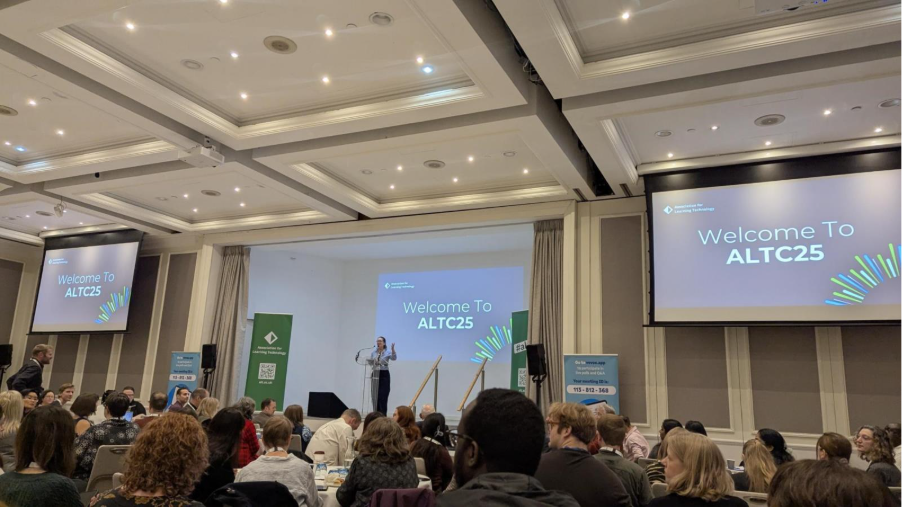Back to Pedagogy
Never having attended the Association for Learning Technologists (ALT) Conference before, I didn’t quite know what to expect. Would it be all about the latest tools? Would it be about what technology can do for us? Would I need to know in advance how to dance a ceilidh? Luckily, ALT 2025’s focus was on what really matters in learning technology — pedagogy first.
Rather than concentrating solely on the newest digital tools, many sessions explored how technology can support, rather than drive, teaching and learning. It was a brilliant mix of perspectives, each connecting innovation back to the student experience.
We All Need to Belong
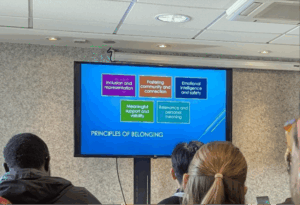
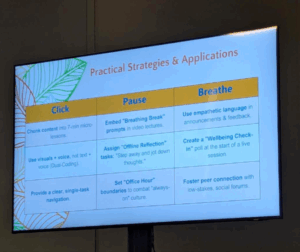
An important thread throughout the conference was wellbeing and belonging. There were excellent discussions about building belonging — not only for students, but also among lecturers and academic staff.
Talks from Zoe Moutsopoulos (Designing for Belonging: Embedding Wellbeing into Digital Learning), Sundus Baig (Click, Pause, Breathe: Embedding Wellbeing in Online Learning Design), and Gabi Witthaus (Engaging Learning: Rethinking Inclusion with Insights from the Margins) focused on how fostering a sense of belonging isn’t just a “nice to have,” but a crucial way to help all students stay, attain, and succeed.
Another interesting talk from Julien le Jeune d’Allegeershecque (Exiting the Silo: Creating a Community for Professionals Involved in the Teaching and Delivery of Online PGT Programmes) explored creating community among lecturers supporting online Postgraduate Taught (PGT) programmes. There’s growing recognition that online learners — and their teachers — need intentional spaces to connect, share challenges, and learn from one another. I left thinking about how platforms like CROPNet could be useful in strengthening that sense of shared practice for tutors within our own institution.
When Students Speak: Learning from Their Perspective
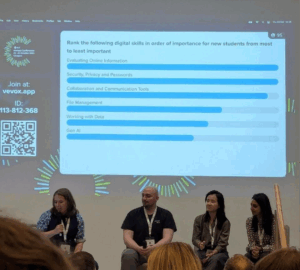
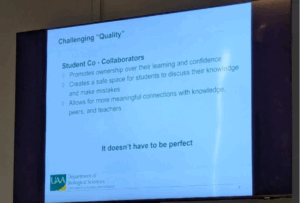
One of the moments that really stood out came during a student-led session. A student commented that she wished her university’s virtual learning environment (VLE) felt more like social media.
At first, many of us smiled or dismissed the idea — after all, academic spaces demand critical thinking and deep reflection, not quick scrolling and likes. But the more I thought about it, the more it resonated.
What I feel she was really expressing was a desire for familiarity and simplicity. Social media offers immediacy, clarity, and structure. You always know where to find things, and the navigation feels intuitive (I would argue more from consistent use than an innate ability). However, that doesn’t mean academia should mimic TikTok (that would be cringe and not fire) — but it does mean we can learn from its usability. If we make learning spaces clearer, more consistent, and easier to navigate, we reduce the cognitive load on students and allow them to focus on thinking critically, not just finding their way around.
I’m happy to say at our university, we’re already making strides toward this idea through initiatives like the Bath Blend, which promotes consistency across Moodle courses. Small changes — clear scaffolding, intuitive labelling, and predictable structure — can make learning more digestible for students without diluting academic rigour.
We don’t need to reinvent the wheel or become content creators. Instead, it’s about using the tools we already know, but rethinking how we present information to better support how students naturally consume and process it.
It was also great to hear what other universities are doing to create clarity and structure. For example, Eddie Joo’s talk, Eclipsing Traditional Textbooks: Using Students as Co-Creators of Learning to Create Open Educational Resources, showcased work from the University of Alaska Anchorage, where staff co-created learning resources with students. Taking feedback from students who found it difficult to navigate the information provided to them, the university aimed to create a single, reliable “source of truth.” This helped reduce students’ anxiety about where to find accurate information — something many of us can relate to.
Managing Change and Motivating People
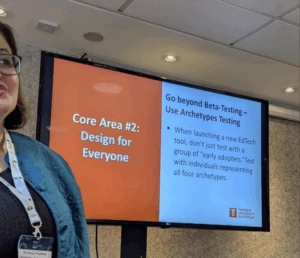
There was also a fascinating session from Dr Arezou PourMirza (Beyond Labels: Personalizing Digital Pedagogy to Empower Every Learner & Educator) on change management that moved beyond the usual focus on “early adopters.” Instead, it explored the different archetypes of people we need to influence when implementing new technologies or pedagogical practices — and the diverse motivations that drive them.
It was a valuable reminder that introducing change isn’t just about innovation itself, but about understanding people and how to bring them along.
GenAI: Clarity Over Complexity
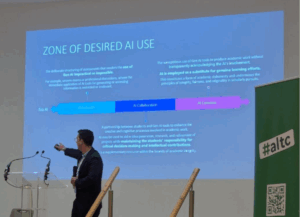
Of course, Generative AI (GenAI) was still a major theme. What struck me most was how the conversation has evolved. The focus is no longer on the novelty of GenAI tools, but on clarity and communication — helping students understand why GenAI is being used in their learning and how it supports their development. When students see purpose and transparency, they’re far more likely to engage meaningfully with it.
There was a lot of discussion around GenAI and academic integrity, but the emphasis is shifting. Instead of asking how to stop students from using GenAI, we’re beginning to ask why they’re using it — and how we can support them to use it effectively and ethically. Many students turn to GenAI because they lack confidence or clarity in their own skills, using it to bridge perceived gaps in understanding.
Teaching students the skills they need to feel capable and confident — in research, writing, and critical thinking — will naturally lead to more responsible, informed use of GenAI. It’s not about banning the technology, but about positioning it as a collaborator, not a crutch.
Talks from Jamie Wood and Jon Chandler (Reimagining Historical Thinking: Aspiring Teachers, GenAI and the Future of Learning) explored this. They showed that encouraging students to develop a more processual perspective — one that helps them understand the stages of learning and reflection — could foster deeper engagement and better use of AI overall.
Final Reflections
There were a lot more “magic”al and informative talks, sadly I couldn’t attend them all, but you’ll be able to find out about some of those from my colleague Olivia Soutter’s reflections on the conference.
Overall, ALT Conference 2025’s focus on pedagogy and the fundamentals of learning and teaching really stood out. Returning to the core questions — how students learn, what they need to succeed, and how we can make learning feel human: connected, consistent, and compassionate — will benefit us all.
Tying back to my earlier reflections on belonging, I also really appreciated the network I formed at the conference. Connecting with peers, hearing about their successes, innovations, and shared challenges left me inspired. The sense of community reinforced the point that professional belonging matters just as much as student belonging.
I’m already looking forward to ALT Conference 2026 — and to continuing these conversations about how we can make learning more meaningful, inclusive, and human.
By Lynn Cheong-White, Curriculum & Academic Developer, and Instructional Designer in the CLT.
Lynn's colleague Olivia Soutter also attended ALT conference, keep an eye on the CLT blogs for further reflections.
